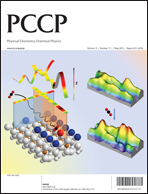Intercalation and de-intercalation pathway of proflavine through the minor and major grooves of DNA: roles of water and entropy†
Abstract
DNA intercalation is a clinically relevant biophysical process due to its potential to inhibit the growth and survival of tumor cells and microbes through the arrest of the transcription and replication processes. Extensive kinetic and thermodynamic studies have followed since the discovery of the intercalative binding mode. However, the molecular mechanism and the origin of the thermodynamic and kinetic profile of the process are still not clear. Here we have constructed the free energy landscape of intercalation, de-intercalation and dissociation from both the major and minor grooves of DNA using extensive all-atom metadynamics simulations, capturing both the free energy barriers and stability in close agreement with fluorescence kinetic experiments. In the intercalated state, an alternate orientation of


 Please wait while we load your content...
Please wait while we load your content...